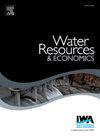Household perception bias on water price in China: Asymmetric impacts and policy treatment
IF 1.9
3区 经济学
Q2 ECONOMICS
引用次数: 0
Abstract
Residents tend to respond to perceived water price rather than the true water price when making household water consumption decisions. The paper estimates household perception bias on the average water price and explores its impact on the adoption of daily water-saving practices, by using the unique 5449 household survey data across 50 cities in China. The bias refers to the discrepancy between perceived price and the true average price. Results from the multi-level regression model show that households can hardly perceive the true average water price accurately. Approximately 71.5 % of households underestimate the true average price to varying degrees. On average, households underestimate the true average water price by 19.3 %, which is equivalent to 0.761 Yuan per ton. There are asymmetric impacts of household perception bias. For one thing, only the underestimation bias significantly impacts on the adoption of both technical and behavioral water-saving measures. For another, it hinders the adoption of technical measures among high water consumption households, while it impedes the adoption of behavioral measures among low water consumption households. Among a total of seven machine learning classification algorithms, the Random Forest binary classifier, based on ten easily-answered feature questions, demonstrates the best performance in identifying households with underestimation bias. It constitutes a promising policy tool to implement information treatment on households with underestimation bias. It can facilitate water conservation resulting from downward perception bias, particularly by tapping into the greater water-saving potential of technical water-saving measures and high water consumption households.
中国家庭对水价的认知偏差:不对称影响与政策处理
居民在进行家庭用水决策时,往往会根据感知到的水价而不是真实的水价作出反应。本文利用中国50个城市5449个家庭调查数据,估算了家庭对平均水价的感知偏差,并探讨了其对日常节水行为的影响。偏差是指感知价格与真实平均价格之间的差异。多层回归模型的结果表明,居民难以准确感知真实的平均水价。大约71.5%的家庭不同程度地低估了真实的平均价格。平均而言,家庭低估了真实平均水价19.3%,相当于每吨0.761元。家庭感知偏差的影响是不对称的。一方面,只有低估偏差对技术和行为节水措施的采用有显著影响。另一方面,它阻碍了高用水量家庭采取技术措施,同时也阻碍了低用水量家庭采取行为措施。在总共7种机器学习分类算法中,随机森林二分类器基于10个容易回答的特征问题,在识别存在低估偏差的家庭方面表现最佳。它是对存在低估偏差的家庭实施信息处理的一种有前景的政策工具。它可以促进由向下认识偏见造成的节约用水,特别是通过利用技术节水措施和高用水家庭的更大节水潜力。
本文章由计算机程序翻译,如有差异,请以英文原文为准。
求助全文
约1分钟内获得全文
求助全文
来源期刊

Water Resources and Economics
Environmental Science-Water Science and Technology
CiteScore
5.00
自引率
0.00%
发文量
17
审稿时长
51 days
期刊介绍:
Water Resources and Economics is one of a series of specialist titles launched by the highly-regarded Water Research. For the purpose of sustainable water resources management, understanding the multiple connections and feedback mechanisms between water resources and the economy is crucial. Water Resources and Economics addresses the financial and economic dimensions associated with water resources use and governance, across different economic sectors like agriculture, energy, industry, shipping, recreation and urban and rural water supply, at local, regional and transboundary scale.
Topics of interest include (but are not restricted to) the economics of:
Aquatic ecosystem services-
Blue economy-
Climate change and flood risk management-
Climate smart agriculture-
Coastal management-
Droughts and water scarcity-
Environmental flows-
Eutrophication-
Food, water, energy nexus-
Groundwater management-
Hydropower generation-
Hydrological risks and uncertainties-
Marine resources-
Nature-based solutions-
Resource recovery-
River restoration-
Storm water harvesting-
Transboundary water allocation-
Urban water management-
Wastewater treatment-
Watershed management-
Water health risks-
Water pollution-
Water quality management-
Water security-
Water stress-
Water technology innovation.
 求助内容:
求助内容: 应助结果提醒方式:
应助结果提醒方式:


